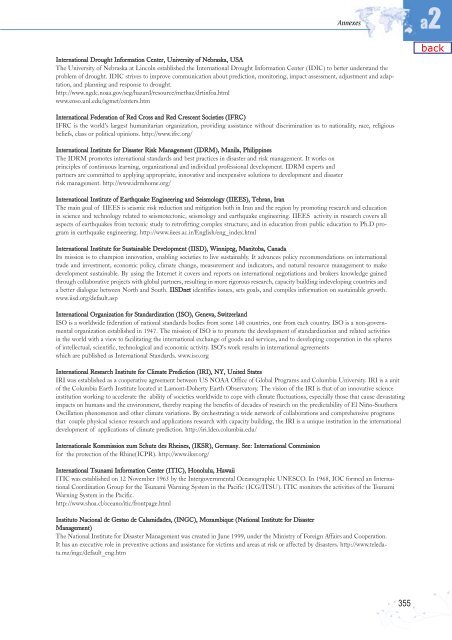Living with Risk. A global review of disaster reduction initiatives
Living with Risk. A global review of disaster reduction initiatives
Living with Risk. A global review of disaster reduction initiatives
Create successful ePaper yourself
Turn your PDF publications into a flip-book with our unique Google optimized e-Paper software.
Annexes<br />
a2<br />
International Drought Information Center, University <strong>of</strong> Nebraska, USA<br />
The University <strong>of</strong> Nebraska at Lincoln established the International Drought Information Center (IDIC) to better understand the<br />
problem <strong>of</strong> drought. IDIC strives to improve communication about prediction, monitoring, impact assessment, adjustment and adaptation,<br />
and planning and response to drought.<br />
http://www.ngdc.noaa.gov/seg/hazard/resource/methaz/drtinfoa.html<br />
www.enso.unl.edu/agmet/centers.htm<br />
International Federation <strong>of</strong> Red Cross and Red Crescent Societies (IFRC)<br />
IFRC is the world’s largest humanitarian organization, providing assistance <strong>with</strong>out discrimination as to nationality, race, religious<br />
beliefs, class or political opinions. http://www.ifrc.org/<br />
International Institute for Disaster <strong>Risk</strong> Management (IDRM), Manila, Philippines<br />
The IDRM promotes international standards and best practices in <strong>disaster</strong> and risk management. It works on<br />
principles <strong>of</strong> continuous learning, organizational and individual pr<strong>of</strong>essional development. IDRM experts and<br />
partners are committed to applying appropriate, innovative and inexpensive solutions to development and <strong>disaster</strong><br />
risk management. http://www.idrmhome.org/<br />
International Institute <strong>of</strong> Earthquake Engineering and Seismology (IIEES), Tehran, Iran<br />
The main goal <strong>of</strong> IIEES is seismic risk <strong>reduction</strong> and mitigation both in Iran and the region by promoting research and education<br />
in science and technology related to seismotectonic, seismology and earthquake engineering. IIEES activity in research covers all<br />
aspects <strong>of</strong> earthquakes from tectonic study to retr<strong>of</strong>itting complex structure; and in education from public education to Ph.D program<br />
in earthquake engineering. http://www.iiees.ac.ir/English/eng_index.html<br />
International Institute for Sustainable Development (IISD), Winnipeg, Manitoba, Canada<br />
Its mission is to champion innovation, enabling societies to live sustainably. It advances policy recommendations on international<br />
trade and investment, economic policy, climate change, measurement and indicators, and natural resource management to make<br />
development sustainable. By using the Internet it covers and reports on international negotiations and brokers knowledge gained<br />
through collaborative projects <strong>with</strong> <strong>global</strong> partners, resulting in more rigorous research, capacity building indeveloping countries and<br />
a better dialogue between North and South. IISDnet identifies issues, sets goals, and compiles information on sustainable growth.<br />
www.iisd.org/default.asp<br />
International Organization for Standardization (ISO), Geneva, Switzerland<br />
ISO is a worldwide federation <strong>of</strong> national standards bodies from some 140 countries, one from each country. ISO is a non-governmental<br />
organization established in 1947. The mission <strong>of</strong> ISO is to promote the development <strong>of</strong> standardization and related activities<br />
in the world <strong>with</strong> a view to facilitating the international exchange <strong>of</strong> goods and services, and to developing cooperation in the spheres<br />
<strong>of</strong> intellectual, scientific, technological and economic activity. ISO’s work results in international agreements<br />
which are published as International Standards. www.iso.org<br />
International Research Institute for Climate Prediction (IRI), NY, United States<br />
IRI was established as a cooperative agreement between US NOAA Office <strong>of</strong> Global Programs and Columbia University. IRI is a unit<br />
<strong>of</strong> the Columbia Earth Institute located at Lamont-Doherty Earth Observatory. The vision <strong>of</strong> the IRI is that <strong>of</strong> an innovative science<br />
institution working to accelerate the ability <strong>of</strong> societies worldwide to cope <strong>with</strong> climate fluctuations, especially those that cause devastating<br />
impacts on humans and the environment, thereby reaping the benefits <strong>of</strong> decades <strong>of</strong> research on the predictability <strong>of</strong> El Niño-Southern<br />
Oscillation phenomenon and other climate variations. By orchestrating a wide network <strong>of</strong> collaborations and comprehensive programs<br />
that couple physical science research and applications research <strong>with</strong> capacity building, the IRI is a unique institution in the international<br />
development <strong>of</strong> applications <strong>of</strong> climate prediction. http://iri.ldeo.columbia.edu/<br />
Internationale Kommission zum Schutz des Rheines, (IKSR), Germany. See: International Commission<br />
for the protection <strong>of</strong> the Rhine(ICPR). http://www.iksr.org/<br />
International Tsunami Information Center (ITIC), Honolulu, Hawaii<br />
ITIC was established on 12 November 1965 by the Intergovernmental Oceanographic UNESCO. In 1968, IOC formed an International<br />
Coordination Group for the Tsunami Warning System in the Pacific (ICG/ITSU). ITIC monitors the activities <strong>of</strong> the Tsunami<br />
Warning System in the Pacific.<br />
http://www.shoa.cl/oceano/itic/frontpage.html<br />
Instituto Nacional de Gestao de Calamidades, (INGC), Mozambique (National Institute for Disaster<br />
Management)<br />
The National Institute for Disaster Management was created in June 1999, under the Ministry <strong>of</strong> Foreign Affairs and Cooperation.<br />
It has an executive role in preventive actions and assistance for victims and areas at risk or affected by <strong>disaster</strong>s. http://www.teledata.mz/ingc/default_eng.htm<br />
355

















